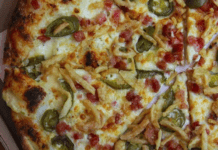it’s not quite true that a global pandemic has revolutionized menu trends across Canada, but what it has done is act as a catalyst for change, forcing foodservice businesses to undergo evolutions in a few months that might otherwise have taken years.
This can be good news for businesses ready to adapt and some prognosticators are cautiously suggesting the post-COVID-19 world will be very favourable for entrepreneurs.
“The industry has gone through such a devastating year, but at the same time there’s so much creativity and innovation; the feeling is that we’re going to come out of this stronger,” says Chris Elliott, senior economist for Restaurants Canada.
Mohamad Fakih, founder and CEO of Toronto-based Paramount Fine Foods, says it’s never been more important to understand and move on industry trends. “Our staff are counting on us entrepreneurs to evolve,” he says. “It’s on us business leaders to make sure our family members are safe.”
International Favourites
Restaurants specializing in international cuisines have an edge, because the average Canadian — already suffering from kitchen fatigue — may not feel competent to whip up falafel or sushi. Some global flavours have a double bonus: they’re perceived as familiar friends (pasta, tacos), but can also entice the adventurous with new flavours.
Technomic identifies Italian, Chinese and Mexican as the three global cuisines that consistently rank highest among foods tried and liked in the U.S. Getting creative with these staples opens the door to menu items such as roujiamo (Chinese street-food meat on a flatbread), plant-based Bolognese sauce or veal-free osso buco and dishes that use the lemony Italian condiment salmoriglio, the heirloom broccoli variety spigarello, the Mexican spice paste chintestle or the herb konjac, a.k.a. devil’s tongue.
North of the border, the Restaurants Canada Chef Survey 2020 found the hottest trends to be Southeast Asian (Thai, Vietnamese, Burmese, Malaysian), followed by Korean, Middle Eastern, Mexican and international fusion. Robert Carter of The StratonHunter Group pinpoints Middle-Eastern cuisine as a rising category.
Who’s doing it right? Probably Freshii, he says, which unveiled its “Plates” program across Canada in November, with take-home dinners such as Moroccan Tahini, Mexican Chimichurri, Mediterranean Pesto and Sesamii Teriyaki ($13.99 each).
Vegan-omics
Many world cuisines derive their protein content from pulses, legumes and grains and creative, vegan-friendly international foods featuring meat alternatives (think Asian tofu creations or Middle-Eastern lentil dishes) promise to hit the target in 2021. Food Network Canada identifies the versatile chickpea and plant jerky among top 2021 trends. Milestones’ new vegan menu — with “Nuevos Rancheros” (with tofu instead of egg), Stuffed Portobello Mushroom Cap ($21) and the Kale Noodle Stir fry ($19) — looks to be on the right track.
Faux Portein
The tumultuous success of plant-based products such as A&W’s Beyond Meat Burger slowed slightly as the country locked down, but Chris Elliott of Restaurants Canada identifies continuing interest from diners who “may not be fully embracing a vegan lifestyle, but still want to do a better job for the environment.”
In July, Harvey’s debuted its plant-based Lightlife Burger, McDonalds has launched its McPlant patty and products such as Sysco Simply Plant-Based Meatballs introduce variety into the mix.
Industry expert Robert Carter predicts “great growth over the next 18 to 24 months, as consumers look at their eating patterns, and a lot of it’s going to skew to health and wellness.”
Menu Tweaks
If lockdowns persist, operators will need to control inventory investment and food waste. Technomic, Inc. expects operators to streamline menus, reducing SKUs and highlighting top-selling and top-earning items to make the most of costs, labour, time and a potentially uncertain supply chain.
But COVID-19 has motivated some operators to create entirely new lines. Vancouver’s upscale Hawksworth Restaurant Group has started a frozen-pizza program that’s so successful it will continue past the pandemic – onsite and in grocery chains. “I would have never stepped into that market,” says chef David Hawksworth.
In Toronto, Middle-Eastern chain Paramount Fine Foods has partnered with celebrity chef Massimo Capra to create MAS.E.MO. Pizza, an Italian-Middle Eastern fusion-pizza concept. “We already have an oven and the staff behind it, so, after the pandemic, I have another brand to sell across Canada,” says Paramount founder and CEO Mohamad Fakih.
Make it to go
Not every meal can survive 30 minutes in a thermal pouch, so takeout is evolving fast. Paramount Fine Foods has fast-tracked its new Box’d concept – a touch-free food-pickup outlet in downtown Toronto. “We started it to resolve the bottleneck in the industry,” says founder and CEO Mohamad Fakih. “You’re only busy for three or four hours; you could cook more foods and deliver them in cubbies.” Box’d allows the restaurant to hire more people into the kitchen than have been lost in table service.
In Vancouver, chef David Hawksworth has leveraged his catering department to create a “Hawksworth-at-Home” program offering seasonal take-home packages, such as six-person Porchetta ($400) or Ribeye ($568) meals and a Hot Toddy Cocktail Kit ($69).
Even furniture giant IKEA has started offering its restaurant fare for takeout in new incarnations, such as a Swedish Meatball Family Meal ($29.99) and a Swedish Veggie Ball Family Meal ($19.99)
Friendly Ghosts
“This is going to be the biggest trend that comes out of [the pandemic]; prior to COVID-19, only about four per cent of restaurants had a ghost kitchen,” says Chris Elliott, senior economist with Restaurants Canada. These delivery-only outlets can save staff, equipment and real-estate costs.
“It was expected to rise to 14 per cent; I think now that number is going to go higher,” he says, noting 55 per cent of Canadians (and 72 per cent of 18-to-34-year-olds) say they feel comfortable ordering from a ghost kitchen.
JOEY Restaurants and Wendy’s opened their own ghost kitchens this year, while Kitchen Hub in Etobicoke, Ont. is a third-party supplier for several brands. In November, Recipe Unlimited launched its second “Ultimate Kitchens” outlet in east-end Toronto, which allows diners to combine delivery orders from multiple Recipe’s brands, including Harvey’s, Swiss Chalet, Montana’s and East Side Mario’s, as well as partners such as Fresh and Blondies Pizza.
“The idea is to create a one-stop location for guests,” says Yianni Fountas, senior director of Emerging Brands & Partnerships, Strategic Projects and Business Insights with Recipe Unlimited. “Our target is to have a national presence by the end of 2021.”
Protein Swaps
Consumers are exploring lesser-known animal proteins in new applications, according to Technomics’ Annual Outlook. Think “eggs on eggs,” as in salmon roe with chicken eggs, and fish or seafood meatballs where you might have expected pork or beef.
Chris Elliott of Restaurants Canada is keeping an eye on “seacuterie,” with varieties of smoked and raw fish instead of the usual cured meats and cheeses. (P.E.I. chef Charlotte Langley taught attendees at the 2020 Devour! Food Film Festival how to erect a magnificent Seacuterie Tower).
This movement is partly driven by health concerns, says The StratonHunter Group’s Robert Carter, and partly because “with the steady increase in consumer education about the types of foods that people are eating, we’re becoming much more adventurous.”
Clean Sweep
After a year dominated by public-health fears, it’s no wonder that cleansing foods are expected to be popular in 2021. Restaurants Canada’s Chef Survey 2020 identified this niche as a top trend, embracing fermented foods such as kimchee and tempeh, as well as naturally raised, antibiotic-free meats.
Food Network Canada has fermented kombucha — including the alcoholic variety — and sauerkraut on its radar, while Technomic’s Annual Outlook foresees increased interest in fresh fruits and vegetables such as unfamiliar citrus varieties (Buddha’s hand, calamansi), new leafy greens (komatsuna), purple foods (purple kale, purple artichoke), sea vegetables and cocktails made with green juices.
Local Heroes
Diners were already supporting local purveyors and ingredients, but now it’s personal. As COVID-19 has shuttered beloved eateries, Canadians are eager to stand behind the places they love. “People are exploring their own neighbourhoods more,” says chef David Hawksworth. “If you can survive, you’ve got a running start in everything.”
“That works all the way from the restaurant to the farmer,” says Chris Elliott of Restaurants Canada. “They want to be able to support Canadian farms, processors and distributors.”
“With people understanding more about the supply chain coming out of the pandemic, this is going to continue to be a huge area,” says The StratonHunter Group’s Robert Carter, who predicts “crazy strategic partnerships” among local players.
Home cooking
Lockdowns that forced Canadians to eat at home have benefitted meal-kit providers such as HelloFresh, Chef’s Plate, GoodFood, Cook It and LiveFit Foods. A January 2020 study by Sylvain Charlebois of Dalhousie University estimated that Canada’s meal-kit industry had tripled in five years and would exceed $400 million in 2020. Now, Robert Carter, industry analyst with The StratonHunter Group, suggests meal kits will “surpass $1 billion in 2021.”
With dining-rooms closed, restaurants are edging into this market with innovations such as Loblaw’s PC Chef service, which is enabling Toronto-area restaurants, including Burger’s Priest, La Carnita, Fresh Restaurants, Fat Lamb Kouzina, General Assembly Pizza, Kinton Ramen and Sala Modern Thai, to offer cook-at-home versions of menu favourites.

















